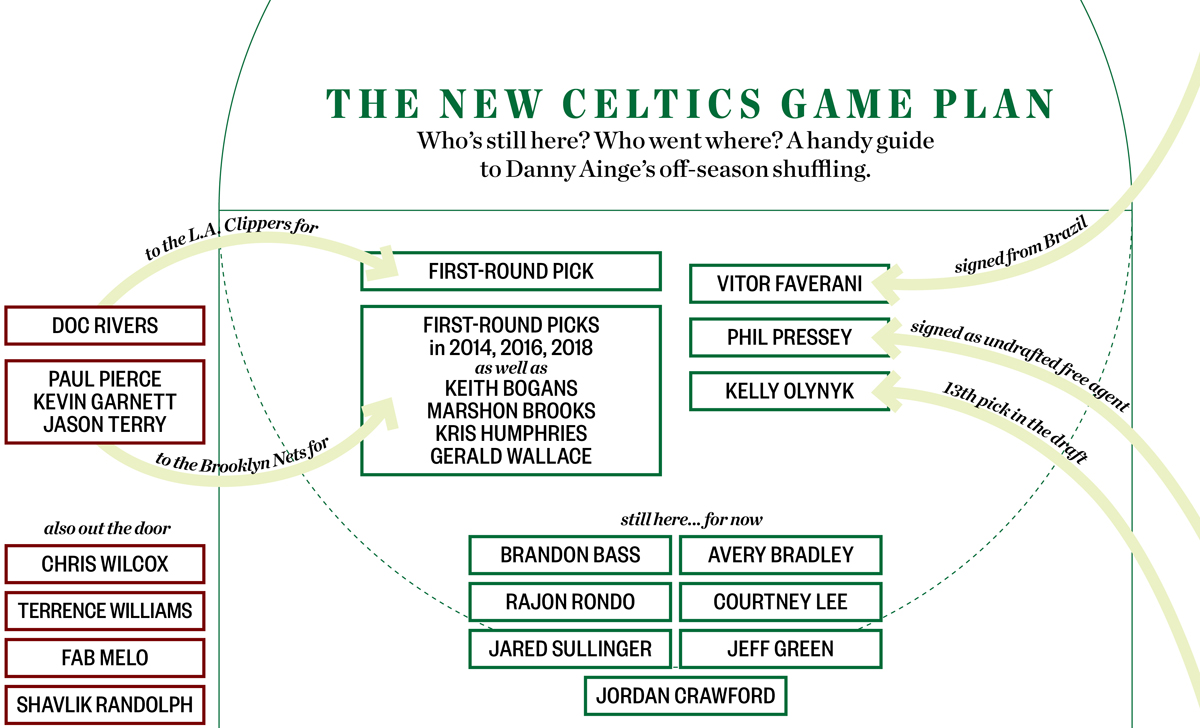Danny Ainge Goes Back to the Drawing Board

Basketball was far from the only thing weighing on his mind. In the first week of training camp before his second season, his mother, Kay, committed suicide, following a lengthy battle with depression. Things came to a head with Fitch later that season, when the coach yanked him out one too many times and Ainge cursed him out on the court. The confrontation continued in the locker room before they finally made peace. Ainge still doesn’t think much of Fitch’s old-school approach. “Personally I think it’s all crap, and I don’t think he toughened me up,” Ainge says.
He eventually found his groove with the Celtics and went on to win two championships, carving out his own niche alongside five future Hall of Famers. After being traded to Sacramento in 1989, he appeared in the NBA Finals with the Blazers and Suns, retiring finally as the NBA’s third-leading all-time three-point shooter.
Less than two years after he retired, Ainge took over coaching duties with the Suns, winning 60 percent of his games before abruptly leaving, saying that he wanted to spend more time with family. In 2003 the new Celtics ownership group, led by Irv and Wyc Grousbeck and Steve Pagliuca, brought him back to Boston to take over basketball operations. Ainge was now in charge of a team that hadn’t won a championship since he’d been in uniform.
It was not long into his tenure before Ainge earned the nickname “Trader Danny.” Raef LaFrentz was in for Antoine Walker—and soon LaFrentz was sent packing himself. Gary Payton made an appearance and then was traded for Walker, who was gone again less than six months later. Round and round it went. Ainge’s moves didn’t always appear to have a clear purpose, as building a coherent roster became less important than collecting players, contracts, and draft picks—“assets,” in NBA parlance—that other teams might find valuable. It was all with an eye toward ultimately building up enough assets to trade for a franchise player.
By the summer of 2007, Ainge was targeting Minnesota’s Kevin Garnett. Many around the NBA think that Ainge was ultimately able to make the KG deal because of his friendship with former Celtics teammate Kevin McHale, who was running the Timberwolves at the time. “I don’t really have a lot of respect for that opinion,” Ainge says. “Kevin ain’t helping me. Kevin and I are very close friends, but we’re trying to compete with each other.”
What did help, Ainge says, is that the Celtics had Al Jefferson, a young, low-post scorer whom McHale coveted. McHale and Ainge had actually worked out a deal for Garnett on draft day in 2007, but when KG balked at signing an extension in Boston, it fell apart. Ainge says he then turned his attention to acquiring Ray Allen—whom he nabbed from the Seattle SuperSonics in a five-player deal.
“I knew that McHale still liked Al and so that allowed us to keep talking, but it didn’t appear there would be a deal,” Ainge says. With Allen in the fold, though, Garnett felt assured that the Celtics could compete, and dropped his opposition to Boston.
With the Big Three in place, the Celtics went on to win the title, and seemed poised for a run of dominance. But just as Ainge was basking in the afterglow of the 2008 championship, he found out that his next year was going to be even more complicated than he thought. He was called to serve as a bishop for the Mormon congregation encompassing Wellesley, Needham, Natick, Dover, and Weston. Forget 15 basketball players—he would now essentially be responsible for more than 400 members of his congregation.
“I honestly didn’t know how I would do it,” Ainge says. “I’m grateful that I did accept the calling. I’m grateful that I had enough faith to accept it and receive it and I don’t think it hindered my job. If anything I think it helped me become a better person and a better leader.”
Ainge and his wife, Michelle, have six children and 11 grandchildren, and he has served numerous callings in the Mormon Church. He rarely talks publicly about his work with the church. While he was bishop, even his closest spiritual advisers didn’t always know everything he was doing, including opening his home to members of the congregation who needed help. “I would find out through third parties they were hosting so-and-so for a month because they had gotten evicted, or so-and-so had run into issues with drugs or alcohol, or they just needed a place to stay,” says Brendaen Makechnie, who served as one of Bishop Ainge’s counselors.
Ainge believes his calling as bishop was aided by his experiences working with players. “I always sort of felt like I was the grandfather of some of the players, particularly the younger players, and Doc was the dad,” Ainge says. “And he was a tough dad. They would come up here and talk to Grandpa, and I would try to calm them down.”
If Ainge was a grandpa, he was a uniquely Machiavellian one. He spent the next five years wheeling and dealing—willing to ship any of his “grandkids” out of town at any moment—to try to get his team another title. But it never happened. The Celtics stumbled through a season of unremarkable mediocrity before suffering a painful first-round playoff loss to the Knicks, during which scoring points seemed like an impossible chore. As the proud Celtics core limped off the court one final time, an air of impending doom hovered around the Garden. No one knew what the future would bring, not even the man responsible for making the decision.


